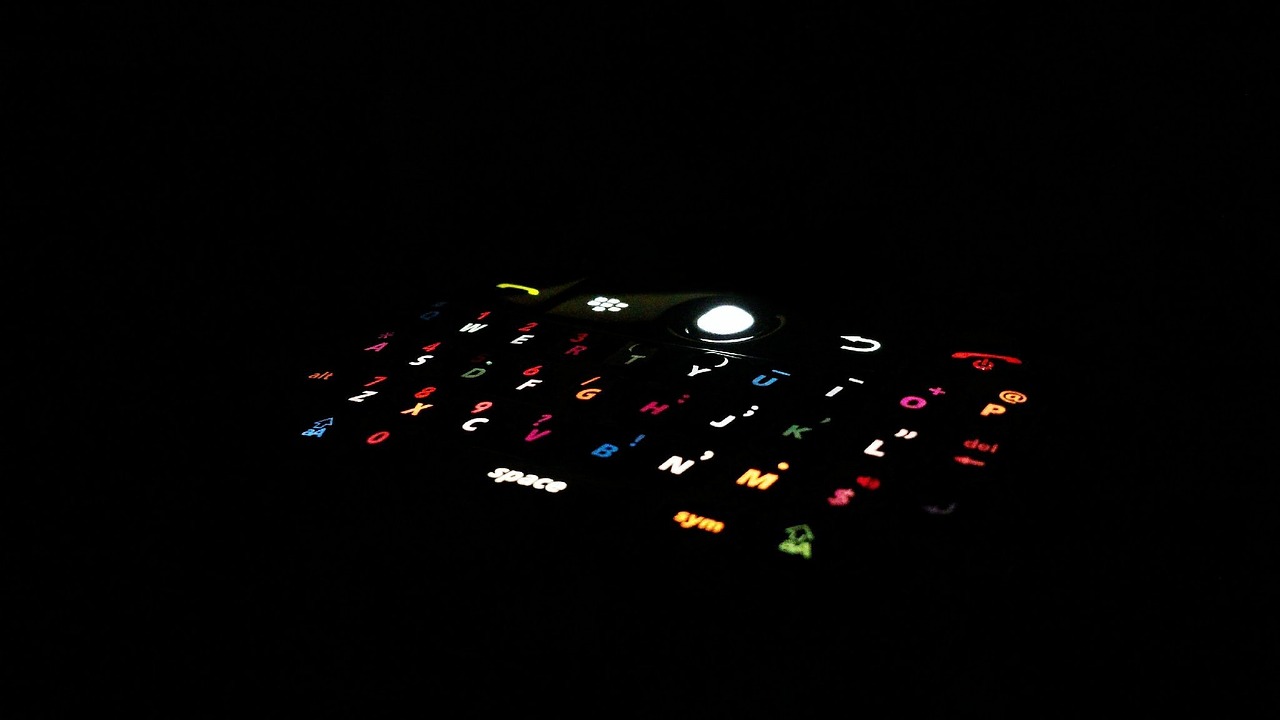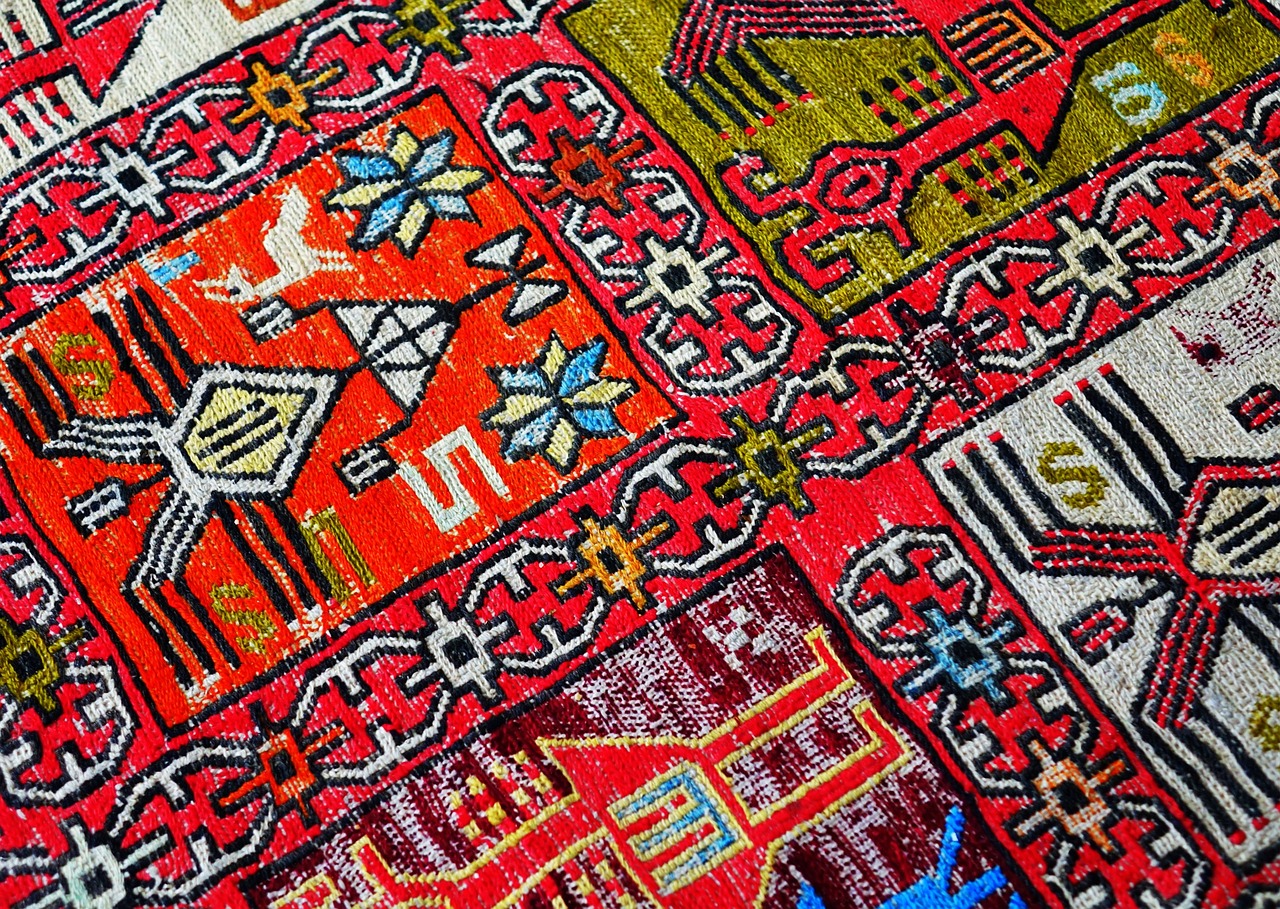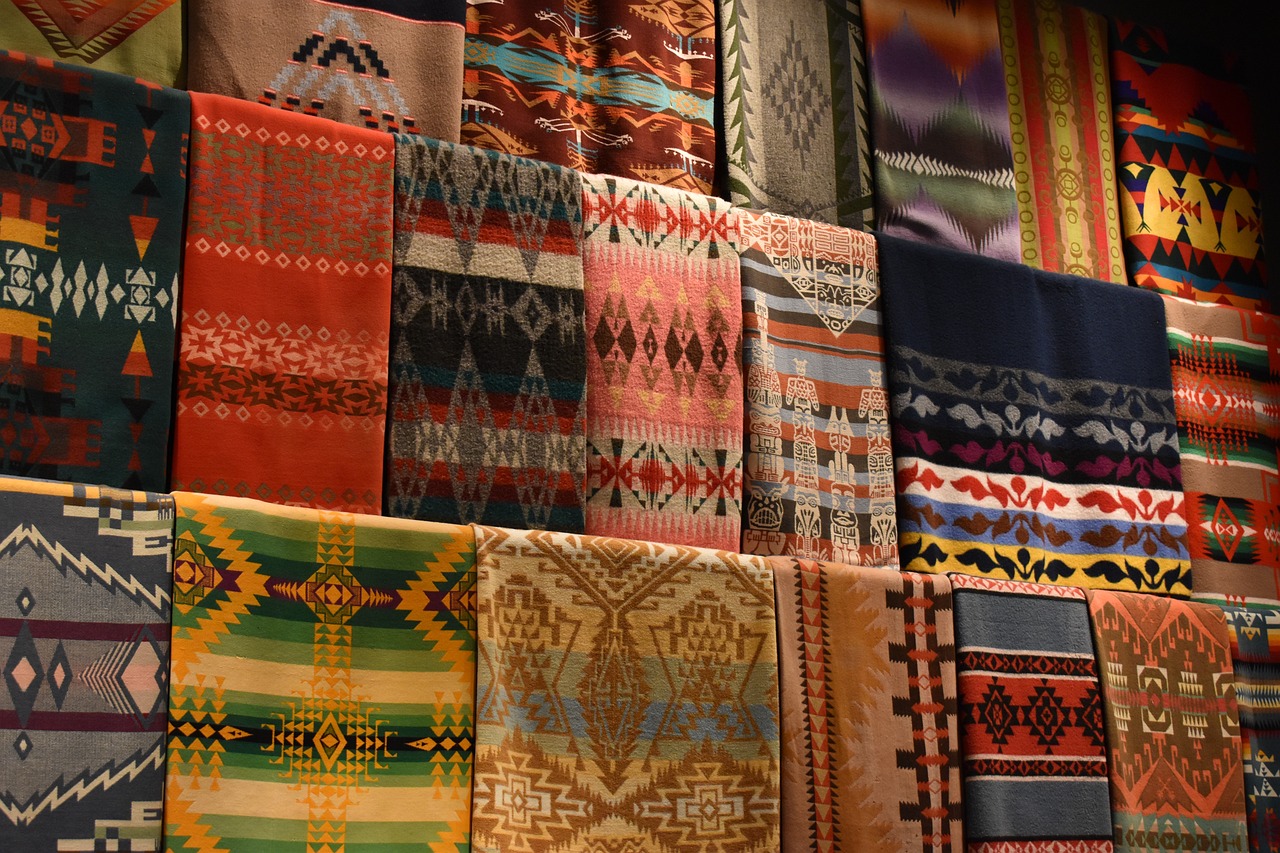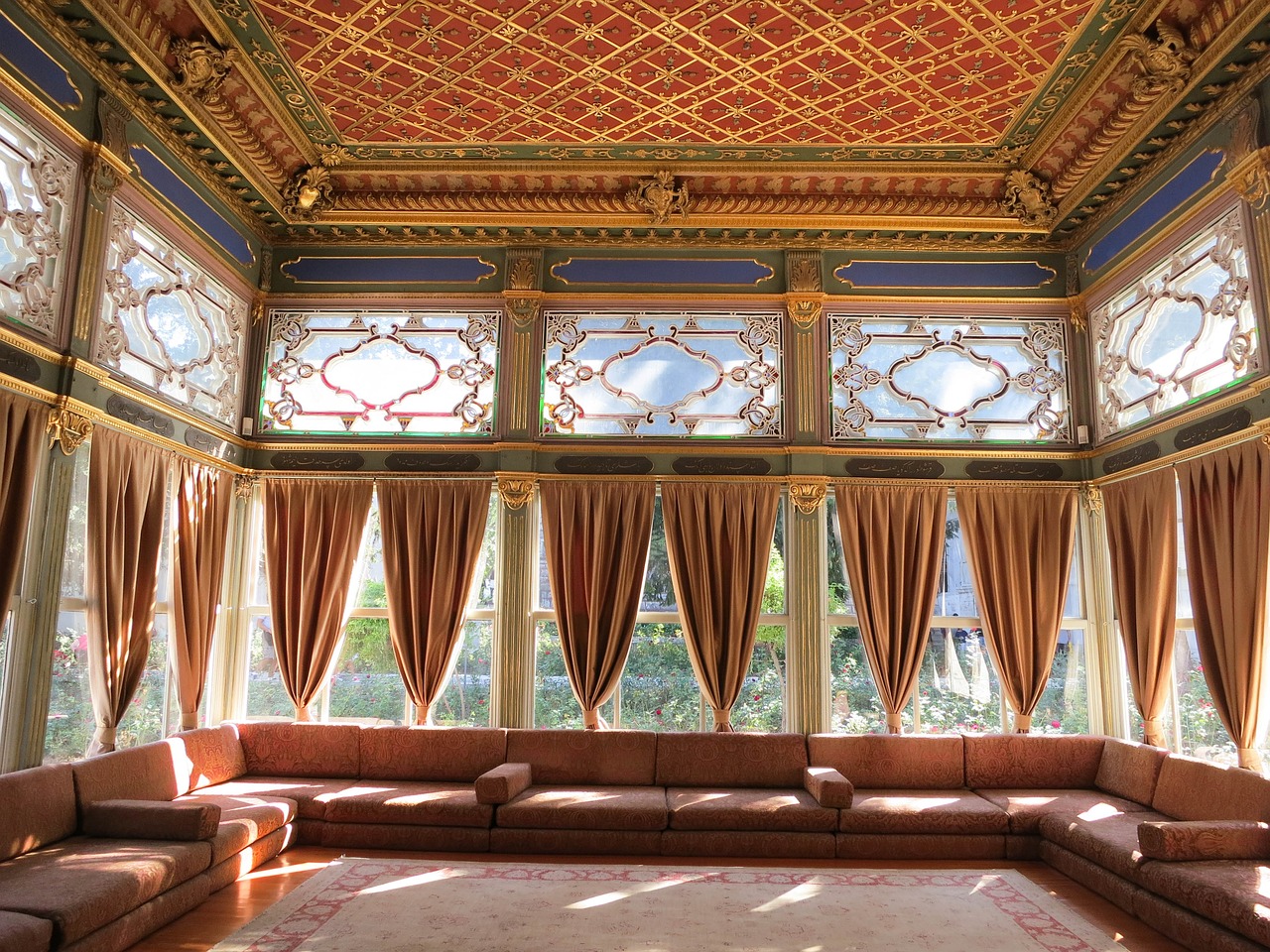DIY Decor Idea: Making a Stencil Rug
Are you ready to transform your living space into something truly special? A stencil rug is not just a piece of fabric; it’s a canvas for your creativity and a reflection of your personal style. Imagine walking into your room, and instead of a bland, generic rug, you see a vibrant, unique design that you crafted yourself. It’s like stepping onto a piece of art every day! In this article, we’ll dive into the creative process of designing and making a stencil rug, offering practical tips and inspiration to enhance your home decor with personalized touches. Whether you're a seasoned DIY enthusiast or a complete beginner, this project is not only enjoyable but also incredibly rewarding. So, roll up your sleeves and let’s get started on this colorful journey!
When it comes to creating a stencil rug, the foundation of your masterpiece lies in the materials you choose. Selecting high-quality materials is crucial for ensuring that your rug is not only beautiful but also durable enough to withstand daily use. First, let’s talk about fabric. Natural fibers like cotton or jute are fantastic options because they are absorbent and provide a sturdy base for paint. Synthetic fabrics can work too, but they might require additional preparation to ensure the paint adheres properly.
Next up is paint. You’ll want to use fabric paint or acrylic paint mixed with a fabric medium. This combination ensures that your colors remain vibrant and that they won’t crack or fade over time. Finally, don’t forget about your tools! A good quality stencil brush, sponge, or spray paint can make a significant difference in the outcome of your project. Here’s a quick overview of what you’ll need:
| Material | Description |
|---|---|
| Fabric | Cotton or jute for durability |
| Paint | Fabric paint or acrylic with fabric medium |
| Tools | Stencil brushes, sponges, or spray paint |
A well-thought-out design is key to your rug's aesthetic. The beauty of a stencil rug lies in the design you choose, which should not only reflect your personal style but also complement the overall decor of your space. So, how do you go about creating or selecting a design? Start by considering the vibe you want to achieve. Are you aiming for something modern and minimalist, or perhaps a bohemian flair? The right design can set the mood for the entire room.
Inspiration can come from various sources, and it’s often where the magic begins. Look around you! Nature, art, and even everyday objects can spark amazing ideas. For instance, the intricate patterns found in leaves or the vibrant colors of a sunset can be translated into stunning stencil designs. Don't underestimate the power of a simple doodle; sometimes, the best ideas come from spontaneous creativity.
In today’s digital age, there’s a treasure trove of design templates and tutorials available online. Websites like Pinterest and Instagram are goldmines for DIY enthusiasts. You can find countless designs ranging from geometric patterns to floral motifs. Just search for “stencil rug designs,” and watch your creative juices flow! These platforms not only provide inspiration but also connect you with a community of fellow DIY lovers.
If you’re feeling adventurous, why not design your own stencil? This step allows you to truly personalize your rug. Start by sketching your ideas on paper. Once you have a design you love, you can transfer it to a stencil format using cardstock or mylar. Remember, the more intricate the design, the more patience it will require, but the result will be worth it!
Before applying your stencil, it’s essential to prepare the rug base properly. This step is crucial for ensuring that the paint adheres well and that your design looks crisp and clean. Start by cleaning the fabric thoroughly to remove any dust or oils. Next, consider priming the rug with a fabric primer to create a smooth surface for painting. Once primed, allow it to dry completely before moving on to the fun part—applying your stencil!
Now comes the exciting part: bringing your design to life! The application process is where your creativity shines. Make sure to position your stencil accurately on the rug, securing it with painter’s tape to prevent any movement. Use a stencil brush or sponge to dab the paint onto the fabric, applying it in a light, even layer. This technique helps achieve clean, crisp lines, which is essential for a professional-looking finish.
Different painting techniques can dramatically affect the final look of your rug. For instance, sponge painting creates a textured effect, while spray painting can provide a smooth finish. Don’t be afraid to experiment with various methods to find what works best for your design. Remember, practice makes perfect!
Layering colors can add depth and interest to your stencil rug. Think of it like painting a beautiful sunset—each layer contributes to the overall effect. Choose colors that complement each other and apply them in layers, allowing each layer to dry before adding the next. This technique will make your rug pop and give it a more dynamic appearance.
Once you’ve applied your design, it’s time for the finishing touches! Adding these details enhances the overall appearance and durability of your rug. Start by sealing your design with a fabric sealer to protect it from wear and tear. Allow your rug to dry completely before moving it into your space. Finally, give it a good care routine to ensure it stays looking fresh for years to come!
- How long does it take to make a stencil rug? The time can vary, but expect to spend a few hours on design and painting, plus drying time.
- Can I use any type of paint? It's best to use fabric paint or acrylic paint mixed with a fabric medium for durability.
- What if I make a mistake while painting? Don’t worry! You can often fix small mistakes with a little touch-up paint.

Choosing the Right Materials
When embarking on the exciting journey of creating your own stencil rug, is absolutely crucial. Imagine putting your heart and soul into a project only to have it fall apart because of subpar supplies! You want your rug to be not just beautiful but also durable, able to withstand foot traffic and the test of time. So, let’s dive into the essential components you'll need for this DIY adventure.
First up, the fabric. The choice of fabric is pivotal because it serves as the foundation of your rug. You’ll want to opt for materials that are both sturdy and easy to work with. Some popular options include:
- Canvas: Highly durable and holds paint well, making it a favorite among DIYers.
- Burlap: Adds a rustic charm but may fray, so be cautious with your design.
- Outdoor Fabric: Ideal if you’re looking to place your rug outside; it's weather-resistant and easy to clean.
Next, let’s talk about paint. Not all paints are created equal, especially when it comes to fabric. You’ll want to choose a paint that adheres well and can withstand wear and tear. Fabric paint is a great option as it’s specifically designed for this purpose. However, if you’re feeling adventurous, acrylic paint mixed with a fabric medium can also do the trick. Just be sure to check the label for washability and durability!
Now, onto the tools—these are your best friends in this creative endeavor. Here’s what you’ll need:
- Stencil Material: You can use plastic sheets, cardboard, or even mylar for making your stencil.
- Brushes and Sponges: Different brushes can create varied effects, while sponges are great for dabbing paint on.
- Masking Tape: Essential for securing your stencil and preventing paint from bleeding.
- Craft Knife: For precise cutting of your stencil design.
Lastly, don’t forget about the finishing products. A good sealant can protect your rug and keep it looking fresh for years to come. Look for a clear, non-toxic sealant that’s safe for fabric and will enhance the durability of your masterpiece.
In summary, your choice of materials will significantly impact the outcome of your stencil rug. By investing in high-quality fabric, paint, and tools, you set the stage for a successful project that not only beautifies your space but also stands the test of time. So gather your supplies, unleash your creativity, and get ready to transform your home with a personalized touch!

Designing Your Stencil
When it comes to crafting a stunning stencil rug, is an essential step that sets the tone for the entire project. A well-thought-out design not only enhances the aesthetic appeal of your rug but also reflects your personal style. So, how do you go about creating or choosing a stencil that will truly make your rug pop? Let's dive into some creative strategies!
First and foremost, consider the theme of the room where your rug will reside. Is it cozy and rustic, or sleek and modern? This will guide your design choices. For instance, if you're aiming for a farmhouse vibe, you might want to incorporate floral patterns or geometric shapes that evoke a sense of warmth and comfort. On the other hand, if your space is more contemporary, think about using abstract designs or bold graphics that add a touch of sophistication.
Inspiration can strike from various sources, and it’s crucial to keep your eyes open. You might find a beautiful pattern on a wallpaper, a stunning piece of artwork, or even a unique texture in nature. Nature often serves as a fantastic muse—think of the intricate designs found in leaves, flowers, or even animal prints. You can capture these elements to create a stencil that feels both organic and refreshing.
Inspiration can come from various sources. Here are a few places to look:
- Nature: Observe the colors and patterns in your surroundings. A walk in the park might reveal some stunning leaf shapes or floral designs.
- Art: Visit galleries or browse online art platforms to see what catches your eye. Art Deco, Impressionism, or even street art can provide great ideas.
- Online Resources: Websites like Pinterest and Instagram are treasure troves for DIY enthusiasts. You can search for stencil ideas and see how others have approached their projects.
Speaking of online resources, there are countless websites and social media platforms dedicated to DIY projects. Websites such as Pinterest and Instagram are particularly useful for discovering stencil templates and tutorials. You can also find communities on forums where fellow DIYers share their experiences and tips. Engaging with these platforms not only provides you with ideas but can also inspire you to think outside the box.
If you’re feeling particularly adventurous, why not design your own stencil? This allows for a truly unique creation that no one else will have. Start with a simple sketch on paper, focusing on shapes and patterns that resonate with you. Once you have a draft you love, you can transfer it to a stencil format using materials like cardstock or plastic sheets. Remember, the key is to keep it simple yet impactful—sometimes less is more!
In summary, designing your stencil is a creative process that invites you to explore your personal style and experiment with various inspirations. Whether you opt for a pre-made template or create a custom design, the most important thing is that it speaks to you and enhances your living space. So grab your sketchbook and let your imagination run wild!

Finding Inspiration
When it comes to creating a stencil rug, the first step is often the most exciting: finding inspiration. Inspiration can strike from the most unexpected places, much like a sudden burst of creativity that lights up your imagination. Think of it as a treasure hunt; you never know what gems you might uncover. Whether you’re flipping through magazines, scrolling through social media, or taking a stroll in nature, ideas are everywhere waiting to be captured. Here are a few avenues to explore:
- Nature: The colors and patterns found in nature can serve as a fantastic source of inspiration. From the intricate designs of leaves to the vibrant hues of flowers, the natural world is a canvas of creativity.
- Art and Design: Visiting local art galleries or browsing online art collections can ignite your creative spark. Consider how famous artists use color and shape to convey emotion—this can guide your stencil design.
- Home Decor Trends: Websites like Pinterest and Instagram are goldmines for home decor ideas. Search for trending styles or hashtags related to DIY projects to see what others are creating.
Once you’ve gathered a few ideas, it’s time to hone in on what resonates with you. Ask yourself questions like: What colors make me feel good? What patterns reflect my personality? It's crucial that the design you choose not only fits your aesthetic but also complements the existing decor in your home. This is where the magic happens—your stencil rug can become a unique expression of who you are.
Don’t forget that inspiration can also come from everyday life. A beautiful piece of fabric you stumble upon at a thrift store, an interesting architectural detail on a building, or even the way shadows dance across the ground can all spark an idea. Keep a sketchbook handy to jot down thoughts and doodles as they come to you. This way, when you're ready to start your project, you have a well of inspiration to draw from.
Finally, remember that your stencil rug doesn’t have to be a direct copy of something you’ve seen. It’s perfectly acceptable to mix and match elements from different sources, creating a design that is uniquely yours. Think of it as a recipe: you can follow the instructions, but adding your own twist makes it special. So go ahead, let your imagination run wild, and watch as your vision transforms into a stunning piece of art for your home!
Q: What materials do I need to make a stencil rug?
A: You will need a durable fabric, fabric paint, a stencil, a brush or sponge, and a protective sealant.
Q: Can I use any fabric for my stencil rug?
A: It's best to use fabric that is suitable for painting, such as canvas or cotton blends, as they hold paint well and are durable.
Q: How do I clean my stencil rug?
A: Gently vacuum your rug and spot clean any stains with a damp cloth. Avoid using harsh chemicals that can damage the paint.

Using Online Resources
In today's digital age, the internet is a treasure trove of inspiration and resources for your DIY projects, including creating a stunning stencil rug. When you dive into the world of online resources, you’ll discover an array of platforms that can help you every step of the way. From design templates to video tutorials, the possibilities are endless. Websites like Pinterest and Instagram are fantastic places to start; they are brimming with creative ideas that cater to every style imaginable. Just imagine scrolling through a feed filled with vibrant designs that spark your imagination!
Moreover, there are specialized websites dedicated to DIY projects that offer not only inspiration but also detailed guides. Websites such as Etsy and Creative Market provide downloadable stencil designs that can save you time and effort. These platforms often feature work from talented artists who have already done the hard work of creating beautiful designs for you to use. You can simply purchase a design that resonates with you and get started!
Additionally, YouTube is an incredible resource for visual learners. You can find countless tutorials that walk you through the process of making a stencil rug from start to finish. Watching someone else tackle the project can demystify the steps and give you the confidence to try it yourself. For instance, channels dedicated to home decor often share tips on the best painting techniques and how to achieve that perfect finish. Just think of it as having a personal tutor who guides you through each phase!
To make your search easier, here’s a quick comparison of some popular online resources:
| Platform | Type of Resource | Best For |
|---|---|---|
| Image Inspiration | Visual Ideas and Trends | |
| Etsy | Stencils and Templates | Purchasing Unique Designs |
| YouTube | Tutorial Videos | Step-by-Step Guidance |
| Creative Market | Digital Downloads | High-Quality Stencil Designs |
As you explore these resources, don’t forget to tap into social media groups and forums where DIY enthusiasts gather. Engaging with a community can provide not only motivation but also valuable feedback on your ideas. Whether you’re sharing your progress or seeking advice, connecting with others who share your passion can be incredibly rewarding. So, go ahead and dive into the online world; your perfect stencil rug design awaits!

Creating Custom Designs
When it comes to making your stencil rug truly one-of-a-kind, creating a custom design is the way to go. Imagine having a piece that not only complements your home decor but also reflects your personality and style. The process of crafting a custom stencil can be both exciting and rewarding, allowing you to unleash your creativity. So, how do you get started?
First, grab a sketchbook and let your imagination run wild. Begin by brainstorming ideas that resonate with you. Think about the themes you love—nature, geometric shapes, or perhaps something abstract. Once you have a few ideas, start sketching them out. Don’t worry about making them perfect; the goal here is to get your creative juices flowing. You might find inspiration in everyday objects like leaves, flowers, or even architectural elements. The world around you can be a treasure trove of design ideas!
After you have a few sketches that you like, it’s time to refine your design. Consider the size of your rug and how the stencil will fit within that space. A design that is too intricate might not translate well when painted, while a simpler design can be more impactful. Think about the negative space—the areas that will remain unpainted—as it plays a crucial role in the overall composition of your rug. Once you are satisfied with your design, it’s time to transfer it to a stencil format.
To create your stencil, you can use materials like mylar sheets or even cardboard. These materials are sturdy enough to withstand the painting process but flexible enough to work with. If your design is intricate, consider using a cutting machine, like a Cricut, which can cut out precise shapes with ease. If you're going the traditional route, a sharp craft knife will do the trick. Just be sure to take your time and cut carefully to ensure clean edges.
Once your stencil is ready, test it on a scrap piece of fabric before applying it to your rug. This practice run will help you understand how the paint behaves and allow you to make any necessary adjustments. Remember, the beauty of creating a custom design lies in the freedom to experiment. Don’t hesitate to play with different shapes, sizes, and even colors until you find the perfect combination that speaks to you.
In summary, creating custom designs for your stencil rug is about embracing your creativity and allowing your personality to shine through. With a little planning and experimentation, you can craft a rug that not only beautifies your space but also tells your unique story.
- What materials do I need to create a stencil? You will need a sturdy material like mylar or cardboard, a craft knife or cutting machine, and paint suitable for fabric.
- Can I use any design for my stencil? Yes, but keep in mind that simpler designs tend to work better for stenciling, especially if they have clear lines and shapes.
- How do I ensure my stencil stays in place while painting? Use painter's tape to secure the edges of your stencil to the rug, preventing it from shifting during the painting process.
- What type of paint should I use for my stencil rug? Fabric paint or acrylic paint mixed with a fabric medium is ideal as it adheres well to fabric and is durable.

Preparing the Rug Base
Before diving into the exciting world of stencil rug creation, it's essential to ensure that your rug base is well-prepared. Think of it as laying the foundation for a house; without a solid base, everything else can crumble. The first step is to choose the right type of fabric for your rug. Popular options include canvas, burlap, and even old towels. Each material has its unique texture and durability, so pick one that matches your vision and intended use.
Once you've selected your fabric, the next step is to clean the surface thoroughly. This is crucial because any dirt or grease can interfere with paint adhesion, leading to a less-than-perfect finish. You can use a mild detergent mixed with water to wipe down the fabric. Make sure to let it dry completely before moving on to the next steps. After cleaning, consider applying a primer. This will not only enhance the vibrancy of your paint colors but also provide a smoother surface for your stencil application. A spray primer works wonders, but if you prefer a brush, ensure you apply it evenly.
Now that your fabric is clean and primed, it's time to set it up for painting. Lay your rug flat on a clean, dry surface. If you're working with a large piece, you might want to tape down the edges to prevent it from moving around while you work. This is where a little preparation goes a long way! You can also use a drop cloth underneath to protect your floors from any paint spills. Remember, the goal is to create an environment that allows you to focus solely on your design without distractions.
Before you start painting, take a moment to visualize your design. It’s helpful to have a clear idea of where each element will go, so you don’t end up with a chaotic masterpiece. If you're feeling unsure, you might want to sketch your design lightly on the fabric with a pencil. This way, you can adjust as needed before committing to paint. The preparation of your rug base is not just about getting it ready for paint; it’s about setting the stage for creativity to flourish!
| Step | Description |
|---|---|
| Choose Fabric | Select a durable material like canvas or burlap. |
| Clean Surface | Use a mild detergent to remove dirt and grease. |
| Apply Primer | Use a spray or brush primer for a smooth surface. |
| Set Up | Lay the rug flat and secure it to prevent movement. |
| Visualize Design | Sketch lightly with a pencil for guidance. |
By following these steps, you’ll have a well-prepared rug base that’s ready to showcase your artistic flair. Remember, preparation is half the battle won. So take your time here, and you'll be rewarded with a stunning stencil rug that you can proudly display in your home!

Applying the Stencil
Now that you've designed your perfect stencil and prepared your rug base, it’s time for the most exciting part: ! This is where all your hard work and creativity come to life. But hold on a second—before you dive in, let’s talk about a few crucial techniques to ensure that your design turns out flawlessly.
First off, you want to make sure that your stencil is securely positioned on the rug. Use some painter’s tape to hold it in place. This will prevent any slipping or movement while you’re painting, which can lead to those dreaded smudges. Imagine trying to paint a masterpiece only to find that the canvas has shifted—frustrating, right? So, take a moment to tape it down properly.
Next, let’s discuss the actual painting techniques. You have a few options here, and the choice can dramatically affect the final look of your stencil rug. Here are some popular methods:
- Sponge Painting: This technique is great for creating a textured look. Simply dab a sponge in your paint and gently press it onto the stencil. It’s like giving your rug a soft, cloud-like feel!
- Brush Techniques: Using a brush allows for more precision. Opt for a stencil brush that’s stiff and flat. Dip it lightly in paint and use a circular motion to apply it. This helps achieve clean, crisp edges.
- Spray Painting: If you’re looking for a quick application, spray paint can be your best friend. Just make sure to spray from a distance to avoid drips. Think of it as giving your rug a light mist, just like watering a plant!
When applying your paint, it’s essential to use a light hand. Too much paint can lead to bleeding underneath the stencil, ruining those sharp lines you’ve worked so hard to create. Instead of slathering on paint, think of it like seasoning your food—less is often more. Start with a thin layer and build up as needed.
Another tip? Layering colors can add incredible depth to your design. If you’re feeling adventurous, consider using multiple colors to create a gradient or ombre effect. Just be sure to let each layer dry before applying the next. You wouldn’t want to mix your colors prematurely, just like you wouldn’t want to mix oil and water!
Once you’ve finished painting, carefully lift the stencil off to reveal your masterpiece. This is the moment you’ve been waiting for! Take a step back and admire your work. But wait—don’t forget the final touches! Allow your rug to dry completely before moving on to sealing it. This ensures that your design remains intact and vibrant for years to come.
In summary, applying the stencil is an exhilarating step in your DIY journey. With the right techniques and a bit of patience, you can create a stunning stencil rug that reflects your unique style. So, roll up your sleeves, grab your tools, and let your creativity shine!
Q: What type of paint should I use for my stencil rug?
A: Fabric paint or acrylic paint mixed with a fabric medium works best for durability and flexibility.
Q: How long should I let the paint dry?
A: It’s best to let each layer dry for at least 30 minutes, but always check the paint instructions for specific drying times.
Q: Can I wash my stencil rug?
A: Yes, but it’s recommended to spot clean or hand wash to preserve the design. Avoid harsh chemicals.
Q: How can I prevent paint bleeding under the stencil?
A: Use a light hand when applying paint and make sure the stencil is securely taped down.

Painting Techniques
When it comes to bringing your stencil rug design to life, the you choose can dramatically affect the final look of your creation. It's not just about slapping some paint on the fabric; it's about creating a masterpiece that reflects your style and enhances your space. So, let’s dive into some popular techniques that can elevate your stencil rug game!
One of the most popular methods is sponge painting. This technique involves using a sponge to apply paint, which can create a soft, textured effect. To achieve this look, you’ll want to dip the sponge lightly into your paint, removing excess paint to avoid drips. Then, gently dab the sponge onto the stencil, allowing the paint to build up gradually. This method is perfect for achieving a more organic, less structured appearance, making it ideal for bohemian or rustic decor styles.
If you’re aiming for a more defined and polished look, consider brush techniques. Using a stencil brush, you can apply paint with precision, ensuring clean lines and sharp edges. It’s essential to use a stippling motion—lightly bouncing the brush up and down against the stencil. This technique allows for control over the amount of paint applied, making it easier to create intricate designs. Plus, you can experiment with different brush sizes to achieve various effects, from fine details to broader strokes.
For those who want to cover larger areas quickly or create a modern vibe, spray painting might be the way to go. This technique can produce a smooth, even finish and is especially effective for geometric or abstract designs. However, it requires a bit more caution. Make sure to work in a well-ventilated area and cover any surrounding surfaces to avoid overspray. A good tip is to hold the spray can about 12 inches away from the stencil to prevent paint from seeping underneath.
Another technique worth mentioning is layering colors. This involves applying multiple colors of paint to your stencil rug, which can add depth and dimension to your design. Start with a base color and allow it to dry completely before applying the next layer. You can either use the same stencil for different colors or create new stencils for each layer. Just remember to let each layer dry before adding the next to avoid muddying your colors.
To sum it up, the painting technique you choose can significantly impact the overall aesthetic of your stencil rug. Whether you opt for the soft texture of sponge painting, the precision of brush techniques, the sleek finish of spray painting, or the dynamic look of layered colors, each method has its unique charm. So, grab your supplies, unleash your creativity, and watch your design come to life!
- What type of paint should I use for a stencil rug? It's best to use fabric paint or acrylic paint mixed with a fabric medium to ensure durability and flexibility.
- How do I prevent paint from bleeding under the stencil? Make sure to secure the stencil firmly to the rug and use a dry brush technique to control the amount of paint applied.
- Can I wash my stencil rug after painting? Yes, but it's recommended to wait at least a week for the paint to cure fully. Hand washing is preferable to maintain the design.
- Do I need to seal my stencil rug? Sealing is optional but recommended for added durability. Use a fabric sealant after the paint has dried completely.

Layering Colors
Layering colors on your stencil rug is not just about slapping on some paint; it’s an art form that can transform a simple design into a vibrant masterpiece. When you think about it, layering is like creating a beautiful sunset, where each hue blends seamlessly into the next, creating depth and interest. In the world of DIY decor, this technique can take your stencil rug from ordinary to extraordinary, making it a focal point in any room.
To start, you’ll want to select your color palette carefully. Think about the mood you want to create in your space. Do you want it to feel warm and inviting with earthy tones, or would you prefer a fresh and lively atmosphere with bright, bold colors? Here are some tips to help you choose:
- Complementary Colors: Choose colors that complement each other. For example, pairing a soft blue with a warm orange can create a stunning visual contrast.
- Analogous Colors: These are colors that sit next to each other on the color wheel, like blue, green, and teal. They blend well and create a harmonious look.
- Monochromatic Scheme: Using different shades of the same color can add depth without overwhelming the design.
Once you’ve chosen your colors, the next step is to think about the application. You can use various techniques to layer your colors effectively:
- Sponge Painting: This method allows for a softer, more textured look. Use a sponge to dab on your colors, starting with the lighter shades and gradually adding darker ones.
- Brush Techniques: A brush can give you more control, especially for detailed areas. Try using a dry brush technique to create a faded effect.
- Spray Painting: For a more uniform layer, spray painting can be effective. Just be sure to use stencils to keep your edges clean.
As you apply your layers, remember to let each layer dry completely before adding the next. This is crucial for achieving clean lines and preventing colors from muddying together. It’s like building a cake; each layer needs to set before you add the frosting on top, or it all becomes a gooey mess! Patience is key here.
After you’ve achieved your desired look, consider adding a final layer of a clear sealant. This not only protects your artwork from wear and tear but also enhances the vibrancy of the colors. Think of it as the cherry on top of your DIY project; it ties everything together and makes your stencil rug ready for everyday use.
In summary, layering colors is an exciting way to express your creativity and personalize your stencil rug. By choosing the right colors and application techniques, you can create a stunning piece that reflects your unique style and enhances your home decor.
Q: How many colors should I use for my stencil rug?
A: It's best to stick with 2-4 colors to avoid overwhelming the design. Choose colors that complement each other for the best results.
Q: Can I use fabric paint for layering colors?
A: Absolutely! Fabric paint is designed for this kind of project and will adhere well to your rug material.
Q: How can I ensure my colors don’t bleed into each other?
A: Make sure each layer is completely dry before adding the next one. Using a stencil can also help maintain clean lines.
Q: What type of sealant should I use after painting?
A: A clear, water-based sealant is recommended as it won’t alter the colors and will provide a protective layer.

Finishing Touches
After putting in all that effort to create your stunning stencil rug, it’s time to focus on the that will elevate your masterpiece. These final steps are crucial not only for the aesthetic appeal but also for ensuring the longevity of your rug. First and foremost, you’ll want to seal your design properly. This is where the magic happens! A good sealant will protect your rug from wear and tear, making it suitable for high-traffic areas in your home.
When choosing a sealant, look for options that are specifically designed for fabric and paint. Applying a sealant can be a bit like putting on the final coat of varnish on a beautiful piece of furniture—it enhances the colors and protects the surface. You can use a spray sealant for an even coat, or a brush for more detailed areas. Just be sure to follow the manufacturer's instructions for the best results.
Next, drying time is essential. Allow your rug to dry completely before placing it in your desired location. Depending on the materials and sealant used, this can take anywhere from a few hours to a full day. Patience is key here! You wouldn’t want to ruin all your hard work by stepping on it too soon. While you wait, consider how you’ll style it in your space. Think about the furniture pieces that will complement your new rug and enhance the overall decor.
Once your rug is dry, it’s time to think about care and maintenance. Regular cleaning will keep your stencil rug looking fresh and vibrant. Depending on the fabric, you might be able to spot clean with a damp cloth and mild detergent. However, for deeper cleans, it’s wise to consult the care instructions specific to your materials. Establish a cleaning routine to prevent dirt and grime from setting in. This will not only maintain the appearance but also prolong the life of your rug.
Finally, consider how you can incorporate your stencil rug into your home decor. Whether it’s in the living room, bedroom, or hallway, the right placement can make all the difference. Think of it as the cherry on top of your decor sundae! A well-placed rug can tie a room together, adding warmth and personality. Don’t be afraid to experiment with different arrangements until you find the perfect spot.
- How long does it take for the sealant to dry? - Typically, sealants can take anywhere from a few hours to 24 hours to dry completely, depending on the type used.
- Can I wash my stencil rug? - It’s best to avoid machine washing. Instead, opt for spot cleaning with a damp cloth and mild detergent.
- What type of paint should I use for fabric? - Fabric paint or acrylic paint mixed with a fabric medium is recommended for durability and flexibility.
- How can I prevent my stencil rug from fading? - Keeping your rug out of direct sunlight can help prevent fading over time.
Frequently Asked Questions
- What materials do I need to make a stencil rug?
To create a stencil rug, you'll need high-quality fabric, fabric paint, a stencil (which can be purchased or custom-made), a cutting tool for the stencil, and painting tools like brushes or sponges. It's important to choose materials that are durable and suitable for the rug's intended use.
- How do I design my stencil?
Designing your stencil can be a fun process! You can either create a custom design by sketching your ideas or use existing templates found online. Make sure your design reflects your personal style and complements your home decor. Don't hesitate to mix and match elements from different inspirations!
- Where can I find inspiration for my stencil design?
Inspiration can be found everywhere! Look to nature, art, and even your favorite patterns or colors. Online platforms like Pinterest, Instagram, and design blogs are treasure troves for creative ideas. Just keep your eyes open, and you'll find something that resonates with you!
- What is the best way to prepare the rug base?
Preparing your rug base is crucial for a successful project. Start by cleaning the fabric to remove any dust or dirt. Then, consider priming it to ensure the paint adheres well. Make sure the surface is flat and secure before you start applying your stencil.
- What painting techniques work best for stencil rugs?
There are several painting techniques you can use to bring your stencil rug to life! Sponge painting offers a soft texture, while spray painting can provide a smooth finish. Brush techniques allow for more control and detail. Experiment with different methods to see what works best for your design!
- How do I layer colors for my stencil rug?
Layering colors can create depth and interest in your design. Start with a base color and let it dry completely before applying additional colors. You can use lighter colors first and then add darker shades for contrast. Just remember to be patient and let each layer dry before moving on!
- What are the finishing touches I should consider?
Finishing touches are essential for enhancing both the appearance and durability of your stencil rug. Consider sealing your design with a fabric sealant to protect it from wear and tear. Allow your rug to dry completely before using it, and follow care instructions to keep it looking fresh!



















